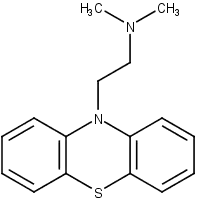Fenethazine
 | |
| Clinical data | |
|---|---|
| Other names | Phenethazinum, Phenethazine, Phenetazine; RP-3015, SC-1627, WY-1143 |
| Identifiers | |
IUPAC name
| |
| CAS Number | |
| PubChem CID | |
| ChemSpider | |
| UNII | |
| KEGG | |
| ChEMBL | |
| CompTox Dashboard (EPA) | |
| ECHA InfoCard | 100.007.570 |
| Chemical and physical data | |
| Formula | C16H18N2S |
| Molar mass | 270.39 g·mol−1 |
| 3D model (JSmol) | |
SMILES
| |
InChI
| |
Fenethazine (INN) (brand names Anergen, Contralergial, Ethysine, Etisine, Lisergan, Lysergan; former developmental code names RP-3015, SC-1627, WY-1143), or phenethazine, is a first-generation antihistamine of the phenothiazine group.[1] Promethazine, and subsequently chlorpromazine, were derived from fenethazine.[2] Fenethazine, in turn, was derived from phenbenzamine.[3]
References
- ↑ Elks J (14 November 2014). The Dictionary of Drugs: Chemical Data: Chemical Data, Structures and Bibliographies. Springer. pp. 434–. ISBN 978-1-4757-2085-3.
- ↑ Dörwald FZ (4 February 2013). Lead Optimization for Medicinal Chemists: Pharmacokinetic Properties of Functional Groups and Organic Compounds. John Wiley & Sons. pp. 301–. ISBN 978-3-527-64565-7.
- ↑ Sneader W (23 June 2005). Drug Discovery: A History. John Wiley & Sons. pp. 404–. ISBN 978-0-471-89979-2.
This article is issued from Offline. The text is licensed under Creative Commons - Attribution - Sharealike. Additional terms may apply for the media files.